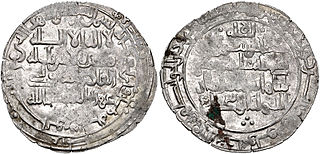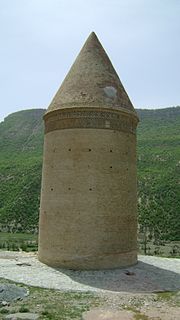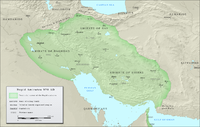
The Buyid dynasty, also spelled Buwayhid, was a Shia Iranian dynasty of Daylamite origin, which mainly ruled over Iraq and central and southern Iran from 934 to 1062. Coupled with the rise of other Iranian dynasties in the region, the approximate century of Buyid rule represents the period in Iranian history sometimes called the 'Iranian Intermezzo' since, after the Muslim conquest of Persia, it was an interlude between the rule of the Abbasid Caliphate and the Seljuk Empire.
Sayyida Shirin, also simply known as Sayyida (سیدا), was a Bavandid princess, who was the wife of the Buyid amir (ruler) Fakhr al-Dawla. She was the de facto ruler of most of Jibal during the reign of her son, Majd al-Dawla.

Abu Kalijar Marzuban was the Buyid amir of Fars (1024–1048), Kerman (1028–1048) and Iraq (1044–1048). He was the eldest son of Sultan al-Dawla.

Abu Shuja, better known by his laqab of Sultan al-Dawla, was the Buyid amir of Fars (1012–1024) and Iraq (1012–1021). He was the son of Baha' al-Dawla.

Abu Nasr Firuz Kharshadh, better known by his laqab of Baha al-Dawla was the Buyid amir of Iraq (988–1012), along with Fars and Kerman (998–1012). His early reign was dominated by struggles with his rival relatives over control of the western Persian provinces, but by 998 he managed to establish his supremacy over the Buyid confederation. His reign nevertheless saw the increasing encroachment of neighbouring powers on Buyid territory, and marks the beginning of the decline of the Buyids' power. He was the third son of 'Adud al-Dawla.

Abu Kalijar Marzuban, also known as Samsam al-Dawla was the Buyid amir of Iraq (983–987), as well as Fars and Kerman. He was the second son of 'Adud al-Dawla. The Abbasids recognized his succession and conferred upon him the title Samsam al-Dawla. He lacked the qualities of his father 'Adud al-Dawla and failed to have a grip upon his state affairs. His rule was marked by revolts and civil wars.
Abu'l-Fawaris, better known by his regnal name Qawam al-Dawla, was the Buyid ruler of Kerman (1012–1028). He was the son of Baha' al-Dawla.
Sama' al-Dawla was the Buyid ruler of Hamadan. He was the son of Shams al-Dawla.
Abu'l-Hasan Ali ibn al-Hasan, better known by his laqab of Fakhr al-Dawla was the Buyid amir of Jibal, Hamadan (984–997) and Gurgan and Tabaristan (984–997). He was the second son of Rukn al-Dawla.

Hasan, better known by his laqab as Rukn al-Dawla, was the first Buyid amir of northern and central Iran. He was the son of Buya.

Abu Talib Rustam, commonly known by his laqab of Majd al-Dawla, was the last amir (ruler) of the Buyid amirate of Ray from 997 to 1029. He was the eldest son of Fakhr al-Dawla. A weak ruler, he was a figurehead most of his reign, whilst his mother Sayyida Shirin was the real ruler of the kingdom.

The Kakuyids were a Shia Muslim dynasty of Daylamite origin that held power in western Persia, Jibal and Kurdistan. They later became atabegs (governors) of Yazd, Isfahan and Abarkuh from c. 1051 to 1141. They were related to the Buyids.

Abu al-Hasan Bahmanyar ibn al-Marzuban, better simply known as Bahmanyar was an Iranian scholar, who is mainly known as one of the most prominent pupils of Avicenna.

Muhammad ibn Rustam Dushmanziyar, also known by his laqab of Ala al-Dawla Muhammad, was a Daylamite military commander who founded in 1008 the short-lived but important independent Kakuyid dynasty in Jibal. He is also known as Pusar-i Kaku, Ibn Kakuyeh, Ibn Kakuya, and Ibn Kaku, which means maternal uncle in the Deylami language, and is related to the Persian word "kaka". Muhammad died in September 1041 after having carved out a powerful kingdom which included western Persia and Jibal. However, these gains were quickly lost under his successors.
Al-Marzuban or Marzuban bin Rustam of Parim, was the thirteenth ruler of the Bavand dynasty from 979 to 986. He was the son and successor of Rustam II. In some sources, his name was changed to Rustam ibn al-Marzuban, which caused confusion among the historians, and made them think that they were two people.

Abu Ja'far Muhammad, was the ruler of the Bavand dynasty from an unknown date until his capture and defeat by the Kakuyids in 1027.
Hasanwayh, also known as Abu'l-Fawaris, was the Kurdish founder of the Hasanwayhid dynasty, ruling from 961 to 979.

Badr ibn Hasanwayh was the second ruler of the Hasanwayhids from 979 to 1014. He was the son and successor of Hasanwayh.

Band-e Amir or Band-e Azodi, is a dam 20 km northeast of the city of Shiraz in Iran, built by the Buyid ruler Adud al-Dawla in 975. It still remains in use till this day.
Bundar Razi was an Iranian poet of the 10th and 11th-centuries, who composed poetry in New Persian and his own local dialect. A native of Ray, Bundar served at the court of the Buyid ruler Majd al-Dawla.














